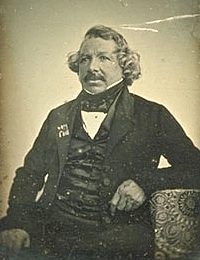

| Louis Jacques Mandé Daguerre |

|
Born November 18, 1787 in Cormeil-les-en-Parisis, died July 10, 1851 in Bry-sur-Marne. French scene painter and physicist, inventor of the daguerreotype, a photograph produced on a silver-coated copper plate treated with iodine vapor. Known first for his illusionistic painted stage sets, Daguerre attracted further attention as the inventor and exhibitor, with C. M. Bouton, of the diorama (pictorial views seen with changing lighting), shown at the Diorama in Paris. In 1829 his experiments with the daguerreotype were joined with those of J. Nicéphore Niépce, who had been doing related work since 1814. Until Niépce's death in 1833 they worked together on the photographic process. Daguerre completed the invention of the daguerreotype alone, and in 1839 it was made public and ceded to the Academy of Sciences, only a few weeks before the rival invention of the calotype was announced by William Henry Fox Talbot. |
 |
|

| Back to the Stereoscopy.com FAQ Page |
